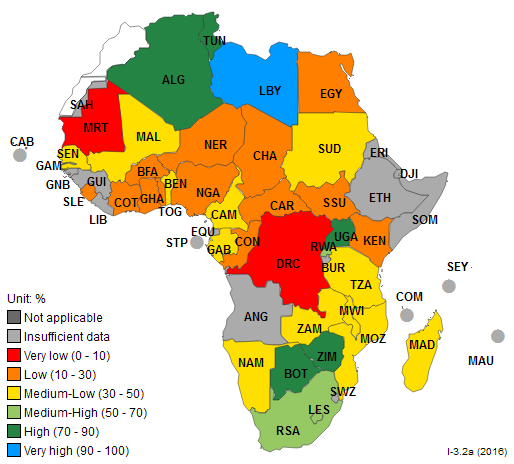Webinar Discusses the Use of Monitoring Data in WASH Sector Decision-Making
Thanks to the Sustainable Development Goals (SDGs), as well as other smaller-scale initiatives throughout the world focused on improving access to water and sanitation, vast amounts of new data are being generated within the water, sanitation, and hygiene (WASH) sector to measure progress against these goals. But are these data being used to inform decisions? And if not, how do we support the use of monitoring data in the decision-making process?
To explore these questions, USAID’s Water for Africa through Leadership and Institutional Support (WALIS) hosted a webinar on June 11 for more than 120 attendees, entitled “Mainstreaming the Use of Data for Decision-Making in Africa’s WASH Sector.” The webinar featured three presenters involved with data generation and use within the African WASH sector.
Marieke Adank, a program officer at IRC, set the stage with the discussion of a case study on how and when monitoring data are being used at different levels in Ethiopia. She explained that data are generally used in two ways—to inform improvement or for accountability. An analysis of monitoring data use in two Ethiopian towns revealed that data informed improvement at the service provider (utility) level. At the service authority level, the study found data being used for both improvement and accountability, but only to a limited extent, and at the national level only for accountability.
Based on this research, Adank developed a matrix to conceptualize how data characteristics (quantity, quality, timeliness, accessibility, and relevance); capacities (individual, organizational, and institutional); and motivations (incentives, interest, and culture) interact and influence each other. Such a framework can be used to identify leverage points that will influence the use of data in decision-making.
While data characteristics are very important, Adank concluded, “If we really want to ensure the use of monitoring data in evidence-based decision-making, we have to […] address issues like culture and incentive structures related to data use. We have to take into account individual capacities to interpret and use data, and organizational capacities related to financial and logistical resources needed for acting on evidence-based decisions. And institutional capacities, including the relationships, and trust relations between organizations.”
The next presenter Nick Dickinson, leader of WASHNote, focused on the AfricaSan initiative, which was established in 2002 to help accelerate progress toward sanitation and hygiene goals throughout Africa and increase investment in the WASH sector. The AfricaSan movement, as of 2015, is guided by the Ngor Declaration and Commitments, which is tied to the SDGs and aims to achieve universal access to adequate and sustainable sanitation and hygiene services and eliminate open defecation by 2030.
These ten commitments, Dickinson emphasized, were developed, and are monitored, through an iterative process: “What’s important to know about the AfricaSan process is that it operates on two levels—there are the declarations and commitments and the ministerial meetings, which are the political track. And there is also a technical track where country governments meet with one another, they share their reports, they share their action plans and also ideas about how they can do better, so there is also a technical exchange.”
The link between data and decision-making is central to the AfricaSan movement. In total, 39 African countries have submitted reports on their progress. Of these, 31 have national monitoring systems, 20 have multi-stakeholder reviews of the SDG targets, and 18 have both. Of those that have both, only 10 countries have reported changing their activities or funding based on the data generated, which suggests a gap between data generation and use in decision-making.
The African Ministers’ Council on Water (AMCOW) is responsible for collecting and analyzing these country reports on the Ngor commitments, and it is also trying to help bridge the gap between data generation and use. Kitch Bawa, sanitation project manager at AMCOW, discussed these efforts in the third and final webinar presentation.

In 2011, AMCOW developed a web-based reporting system, WASSMO (Water Sector and Sanitation Monitoring), to track progress against the Ngor commitments’ predecessor, the eThekwini commitments. WASSMO includes data on 43 indicators, focused around seven themes, including: WASH and wastewater; governance and institutions; financing; and information management and capacity. The evidence collected within this system has already been used to inform key decisions, including the Kigali Action Plan, which targeted the ten countries that reported the least progress on water and sanitation access to help accelerate action.
Despite this success, Bawa noted that many challenges persist when it comes to using data in decision-making. For instance, prioritization of monitoring and evaluation is low, data collection is inadequate, national coordination platforms are often weak, funding is limited, and ownership and institutionalization at the country level is lacking. With these challenges in mind, Bawa stressed the importance of getting relevant, timely data to decision-makers during the budgeting and planning cycle so they can inform resource allocation decisions.
After the presentations, WALIS Chief of Party Rich Rapier moderated a Q&A session. The discussion underlined a key message from the presentations: enabling the use of data in decision-making requires a balance of the political and the technical. Good data are needed for good policy, but political drive is required for change.
- Learn more about the event
- Download presentations (via Google Drive)
By Katie Connolly, Program Coordinator for WALIS

